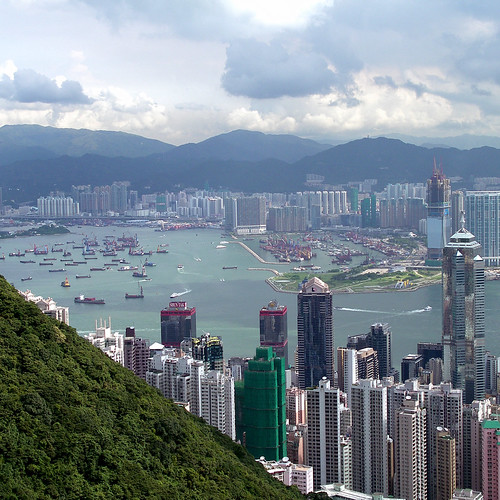
Hong Kong's density is a little like New York's... except it's on roids. Image Flickr user by Brad-514.
In terms of financial viability, public transportation in North America is a perpetual loser. However, rumours have it that some transit agencies abroad break even or even make a profit. So let us take a closer look into one of these transit agencies – Hong Kong’s MTR (Mass Transit Railway) – and see if its profitability scheme could work in your city:
Hong Kong’s population: 7 million
Year MTR was established: 1979
Kilometers of rail in 1984: 66
In 2004: 255
Daily ridership in 2011: 4 million
Percentage of public transport trips taken on MTR: 42
Average fare increase of MTR since 1979: 5.6% per annum
Average growth rate of Consumer Price Index: 5.6% per annum
Percentage more high depreciation and financing costs are compared to recurrent operating costs: 25
Percentage increase in MTR’s non-fare revenue (i.e. developing and enhancing commercial activities) for past 20 years: 50
Percentage of total operating costs due to high depreciation and financial burden of recent/new rail projects: 50
Percentage of railway operating revenue derived from: 1) property development profit and; 2) rental and management income: 50
Percentage of MTR’s profits (before tax) generated by: 1) property development profit and; 2) rental and management income: 90 *
Per-unit operating cost before depreciation and interest of Hong Kong’s KMB (Kowloon Motor Bus) bus operations: HK$0.10 per passenger space-km
MTR: HK$0.09 per passenger space-km
Operating Cost after depreciation and interest for KMB: HK$0.12
MTR: HK$0.18 * (explanation below)
Indirect subsidies available to MTR: Granted exclusive right to real estate property development above railway stations **
Cost of 1200 square foot “old” apartment unit: USD $1.9 million
Cost per square foot of “top” end properties: $10,500
Percentage more costly compared to London, New York and Moscow: 40
Population density: 6,500 persons per square kilometer
Most densely population district in Hong Kong: Kwun Tong
Population density: 53,110 persons per square kilometer
* While the government builds and maintains roads at no cost to bus operators (i.e. bus operating companies use roads for free), MTR funds, builds and owns the railway infrastructure/assets. As such, the operating cost after depreciation and interest for rail operations are always higher than bus operations.
** The local government in Hong Kong virtually owns all land. Given MRT’s exclusive property rights given to them by the government, MRT does not need to go through public auction as is normal for land sale in Hong Kong. Instead, MTR pays a premium that’s determined through negotiations and they earn development profits that payback rail investments. In other words, without development rights above railway stations, MTR is unable to earn a viable return.
